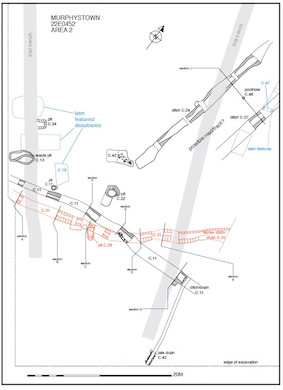County: Dublin Site name: LISIEUX HALL, Murphystown
Sites and Monuments Record No.: N/A Licence number: 22E0452
Author: Caitríona Moore and Wayne Malone, ABH Ltd.
Site type: Post-medieval
Period/Dating: Post Medieval (AD 1600-AD 1750)
ITM: E 719240m, N 725249m
Latitude, Longitude (decimal degrees): 53.264169, -6.212606
The site lies in the former grounds of a Victorian-era house, ‘Lisieux Hall’ (Reg No. 60230006), which does not form part of the development site. Assessment and test trenching was completed under this licence in 2022. The excavation covered an area of approximately 1.19ha across the northern extent of the overall 1.85ha development. This was undertaken from 10 to 27 January 2023. Additional monitoring of groundworks was completed in late February 2023.
The excavation revealed a quarry pit (C021) across the north-eastern extent of the site (Area 1) The rectangular-shaped pit (L 13.3; W 10.3; D 0.8–2m) was hand-cut into the shallow granite bedrock and had rough jagged edges, exhibiting occasional tool marks. The quarry was filled with several clay deposits (D 800–2000mm), yielding a small number of seventeenth- to nineteenth-century pottery sherds. The remains of nineteenth- and twentieth-century brick walls were also identified in Area 1. These were associated with the Victorian-era walled garden and formed sheds and/or greenhouses as depicted on early OS editions.
A range of earth-cut features were recorded across the western extent of the site (Area 2). The features comprised pits, linear ditches and drains, all of which had been truncated by twentieth-century landscaping. A refuse pit (C013; L 2950mm; W 2400mm; D 360mm) filled by three distinctive deposits, produced an assortment of nineteenth-century utilitarian objects, including corroded metal buckets and saucepans alongside glass and ceramic bottles. Additional pits were quite sterile in nature with the exception of a sub-rectangular pit (C037; L 1180mm; W 1120mm; D 530mm) which yielded a flint flake and core alongside North Devon ware pottery sherds.
A possible post-hole (C048; L 300mm; W 300mm; D 170mm) yielding oyster shell and animal bone fragments was located between two heavily truncated ditches (C024 and C027). The two shallow ditches ran parallel to one another (north-north-east/south/south/west). One ditch fill yielded a George II (1727–1760) halfpenny and a sherd of Westerwald pottery. This ditch was cut by a land drain which produced a flint core. The adjacent ditch was also cut by a later linear feature which itself yielded a prehistoric flint flake alongside a Dutch glass bottle, English stoneware vessels and a clay pipe stem.
A relatively large east-west linear ditch (C031; L 25m; W 1000–1400mm; D 800mm) extended across much of Area 2. The ditch fill contained prehistoric finds alongside post-medieval material. These included a fragment of a saddle quern, a flint flake, a machine-made copper alloy mount, a sherd of Manganese mottled ware and two clay pipe stems. This feature was truncated by a later irregularly-cut ditch (C011; L 23m; W 600–1800mm; D150–250mm). A north-south linear stone-lined land drain (C045; L 10m; W 550–650mm; D1200mm) produced eighteenth- and nineteenth-century pottery.
The excavation at Lisieux Hall predominantly revealed features of eighteenth- to early twentieth-century date. The small collection of lithics and the saddle quern fragment hint at prehistoric activity on the site, but no definite prehistoric features were identified.

Spade Enterprise Centre, St. Paul's Smithfield, North King Street, Dublin 7